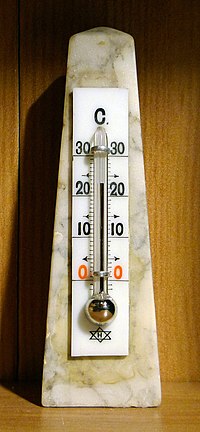
Photo from wikipedia
Little monitoring has been conducted of temperature and humidity inside homes despite the fact that these conditions may be relevant to health outcomes. Previous studies have observed associations between self-reported… Click to show full abstract
Little monitoring has been conducted of temperature and humidity inside homes despite the fact that these conditions may be relevant to health outcomes. Previous studies have observed associations between self-reported perceptions of the indoor environment and health. Here, we investigate associations between measured temperature and humidity, perceptions of indoor environmental conditions, and health symptoms in a sample of New York City apartments. We measured temperature and humidity in 40 New York City apartments during summer and winter seasons and collected survey data from the households’ residents. Health outcomes of interest were (1) sleep quality, (2) symptoms of heat illness (summer season), and (3) symptoms of respiratory viral infection (winter season). Using mixed-effects logistic regression models, we investigated associations between the perceptions, symptoms, and measured conditions in each season. Perceptions of indoor temperature were significantly associated with measured temperature in both the summer and the winter, with a stronger association in the summer season. Sleep quality was inversely related to measured and perceived indoor temperature in the summer season only. Heat illness symptoms were associated with perceived, but not measured, temperature in the summer season. We did not find an association between any measured or perceived condition and cases of respiratory infection in the winter season. Although limited in size, the results of this study reveal that indoor temperature may impact sleep quality, and that thermal perceptions of the indoor environment may indicate vulnerability to heat illness. These are both important avenues for further investigation.
Journal Title: International Journal of Biometeorology
Year Published: 2017
Link to full text (if available)
Share on Social Media: Sign Up to like & get
recommendations!